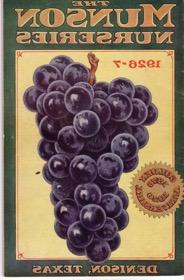得克萨斯州的葡萄人:T.V. 芒森
 曼森,托马斯·沃尔尼 (1843–1913). 托马斯·沃尔尼·曼森, viticulturalist, 威廉和玛丽亚(林利)曼森的儿子, 出生在阿斯托里亚, 伊利诺斯州, 9月26日, 1843. 他成为研究美洲本土葡萄品种的主要专家之一, 他的研究在19世纪后期拯救了欧洲葡萄和葡萄酒工业. 从孩提时代起,曼森就表现出对园艺的兴趣. 19世纪60年代,他在伊利诺斯州的一所学校教了三年书, 1870年,他从列克星敦的肯塔基大学毕业. 1870年至1870年,他在那里担任科学教授. 当他宣布葡萄是“最美丽的”时,他指明了自己的职业发展方向, 最健康,最有营养, 可以种植的最可靠、最赚钱的水果.6月27日,曼森与艾伦·斯科特·贝尔结婚, 1870, 从1871年到1873年,她和父亲一起在托儿所工作, 查尔斯·斯图尔特·贝尔. 1873年,孟森一家搬到了内布拉斯加州, 托马斯在这里开始了他作为园艺师和葡萄栽培师的职业生涯. 他在林肯开了一个小型园艺苗圃. 曼森在当地的砧木上进行试验, but found little success because of the area's weather extremes; he once remarked that the droughts, 严冬, 蚱蜢使一个苗圃工人的生活很困难. 即便如此,他还是开始注意到北方 狐狸 和 酿酒用葡萄 我们会受到各种疾病的侵袭,但本地或野生葡萄却很少受到疾病的侵袭.
曼森,托马斯·沃尔尼 (1843–1913). 托马斯·沃尔尼·曼森, viticulturalist, 威廉和玛丽亚(林利)曼森的儿子, 出生在阿斯托里亚, 伊利诺斯州, 9月26日, 1843. 他成为研究美洲本土葡萄品种的主要专家之一, 他的研究在19世纪后期拯救了欧洲葡萄和葡萄酒工业. 从孩提时代起,曼森就表现出对园艺的兴趣. 19世纪60年代,他在伊利诺斯州的一所学校教了三年书, 1870年,他从列克星敦的肯塔基大学毕业. 1870年至1870年,他在那里担任科学教授. 当他宣布葡萄是“最美丽的”时,他指明了自己的职业发展方向, 最健康,最有营养, 可以种植的最可靠、最赚钱的水果.6月27日,曼森与艾伦·斯科特·贝尔结婚, 1870, 从1871年到1873年,她和父亲一起在托儿所工作, 查尔斯·斯图尔特·贝尔. 1873年,孟森一家搬到了内布拉斯加州, 托马斯在这里开始了他作为园艺师和葡萄栽培师的职业生涯. 他在林肯开了一个小型园艺苗圃. 曼森在当地的砧木上进行试验, but found little success because of the area's weather extremes; he once remarked that the droughts, 严冬, 蚱蜢使一个苗圃工人的生活很困难. 即便如此,他还是开始注意到北方 狐狸 和 酿酒用葡萄 我们会受到各种疾病的侵袭,但本地或野生葡萄却很少受到疾病的侵袭.
为了躲避恶劣的天气,1876年4月,曼森搬到了德克萨斯州的丹尼森. 他的兄弟们 威廉·本杰明·曼森 和J. T. 芒森 lived in the area 和 were involved in insurance 和 real estate businesses; eventually Thomas  开始涉足房地产业务,以及其他方面的努力. 威廉把大部分时间都花在了生意上, 但托马斯开始沉浸在他真正的爱情葡萄中. 他很快意识到德克萨斯州的巨大生物多样性,并很快开始进行广泛的收集旅行. 在他的余生中,他游历了德克萨斯州和其他40个州, 以及墨西哥, 覆盖50多个,乘火车可达1000英里,骑马或步行可达数百英里. 他曾写道,这些旅行“重新点燃了我对葡萄实验工作的热情”.曼森很快就开始发表他的收集旅行和观察结果. 他写了很多关于分类的文章, 杂交, 还有葡萄的种类, 刊登于 美国农学家, 农场和牧场,和 葡萄栽培大道. 1883年,他获得了肯塔基州农业和机械学院的理学硕士学位, 德克萨斯州的森林和森林树木, 这篇文章最终发表在 美国林业杂志. 1885年,他在新奥尔良为美国园艺学会展出了一份完整的分类植物标本室,其中包括所有已知的美国葡萄品种. These were displayed in glass frames; he also had plants of the same species growing in pots. 这些工作的大部分成为了园艺当局关于葡萄的权威来源. 1893年,他在芝加哥的哥伦比亚博览会上展出了他收集的葡萄品种. 孟森的大部分工作都集中在改良不同品种的美国葡萄上, 他的研究导致了300多种葡萄品种的引进. 1909年他出版了他的 美国葡萄栽培的基础的标准参考 葡萄文化 在美国.
开始涉足房地产业务,以及其他方面的努力. 威廉把大部分时间都花在了生意上, 但托马斯开始沉浸在他真正的爱情葡萄中. 他很快意识到德克萨斯州的巨大生物多样性,并很快开始进行广泛的收集旅行. 在他的余生中,他游历了德克萨斯州和其他40个州, 以及墨西哥, 覆盖50多个,乘火车可达1000英里,骑马或步行可达数百英里. 他曾写道,这些旅行“重新点燃了我对葡萄实验工作的热情”.曼森很快就开始发表他的收集旅行和观察结果. 他写了很多关于分类的文章, 杂交, 还有葡萄的种类, 刊登于 美国农学家, 农场和牧场,和 葡萄栽培大道. 1883年,他获得了肯塔基州农业和机械学院的理学硕士学位, 德克萨斯州的森林和森林树木, 这篇文章最终发表在 美国林业杂志. 1885年,他在新奥尔良为美国园艺学会展出了一份完整的分类植物标本室,其中包括所有已知的美国葡萄品种. These were displayed in glass frames; he also had plants of the same species growing in pots. 这些工作的大部分成为了园艺当局关于葡萄的权威来源. 1893年,他在芝加哥的哥伦比亚博览会上展出了他收集的葡萄品种. 孟森的大部分工作都集中在改良不同品种的美国葡萄上, 他的研究导致了300多种葡萄品种的引进. 1909年他出版了他的 美国葡萄栽培的基础的标准参考 葡萄文化 在美国.
 曼森的工作使他能够帮助拯救欧洲葡萄和葡萄酒工业免受毁灭性的真菌和昆虫的袭击. 在19世纪40年代,欧洲的葡萄园遭到了真菌寄生虫的蹂躏 粉孢子. 在那段时间里,法国损失了近80%的葡萄树. 欧洲葡萄酒工业进口本地葡萄酒 狐狸 来自美国的砧木,但这些插枝带来了 葡萄根瘤蚜, 一种植物虱,它袭击了正在缓慢恢复的葡萄园. In 1868 葡萄根瘤蚜 was discovered in southern France; more than 6 million acres of vineyards were destroyed in France, 德国, 以及欧洲其他地区. 法国葡萄酒产业, 知道了曼森的专长, 请求他送一些他在丹尼森学习期间培育的葡萄杂交根茎. 他运 葡萄根瘤蚜在法国,它被嫁接了各种欧洲品种 酿酒用葡萄. 和另一位园艺学家的作品, 赫尔曼Jaeger, 挽救了欧洲葡萄酒产业,使其免于彻底毁灭. 因为曼森的角色, 1888年,法国政府派了一个代表团去拜访丹尼森,授予他法国荣誉军团的荣誉骑士勋章. 曼森还获得了许多其他奖项和荣誉. 1898年,他被选为法国国家农业协会的外国通讯会员,并被选为法国葡萄种植者协会的荣誉会员. 1906年,肯塔基大学授予他荣誉理学博士学位. 他是德克萨斯园艺学会的创始人和主席,也是美国园艺学会和美国果树学会的成员. 1903年至1904年,他还是德克萨斯州世界博览会委员会的成员. 路易博览会.
曼森的工作使他能够帮助拯救欧洲葡萄和葡萄酒工业免受毁灭性的真菌和昆虫的袭击. 在19世纪40年代,欧洲的葡萄园遭到了真菌寄生虫的蹂躏 粉孢子. 在那段时间里,法国损失了近80%的葡萄树. 欧洲葡萄酒工业进口本地葡萄酒 狐狸 来自美国的砧木,但这些插枝带来了 葡萄根瘤蚜, 一种植物虱,它袭击了正在缓慢恢复的葡萄园. In 1868 葡萄根瘤蚜 was discovered in southern France; more than 6 million acres of vineyards were destroyed in France, 德国, 以及欧洲其他地区. 法国葡萄酒产业, 知道了曼森的专长, 请求他送一些他在丹尼森学习期间培育的葡萄杂交根茎. 他运 葡萄根瘤蚜在法国,它被嫁接了各种欧洲品种 酿酒用葡萄. 和另一位园艺学家的作品, 赫尔曼Jaeger, 挽救了欧洲葡萄酒产业,使其免于彻底毁灭. 因为曼森的角色, 1888年,法国政府派了一个代表团去拜访丹尼森,授予他法国荣誉军团的荣誉骑士勋章. 曼森还获得了许多其他奖项和荣誉. 1898年,他被选为法国国家农业协会的外国通讯会员,并被选为法国葡萄种植者协会的荣誉会员. 1906年,肯塔基大学授予他荣誉理学博士学位. 他是德克萨斯园艺学会的创始人和主席,也是美国园艺学会和美国果树学会的成员. 1903年至1904年,他还是德克萨斯州世界博览会委员会的成员. 路易博览会.
曼森继续和他的妻子和七个孩子住在丹尼森,直到他去世, 1月21日, 1913. 1975年左右,谢尔曼-丹尼森地区的体育博彩平台建立了托马斯·沃尔尼·曼森纪念葡萄园,以表彰曼森对园艺的贡献,并培育和保存了许多曼森葡萄品种. 在1988年. V. 曼森葡萄栽培和酿酒中心在葡萄园旁边开业. 法国竖立了几座纪念曼森的雕像.

